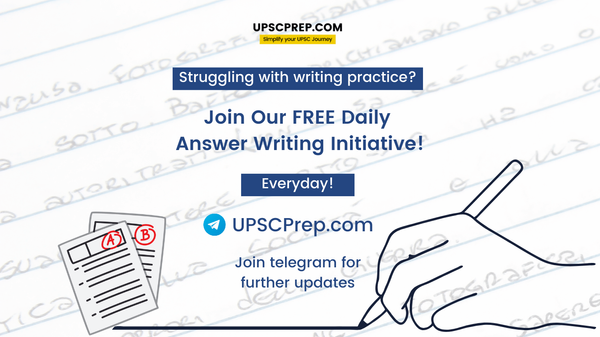Subject: GS 4
Syllabus: Case Study
Questions
- You are recently posted as a District Magistrate in a district where the practice of manual scavenging is rampant. You notice that despite laws and court orders, manual scavenging continues where humans clean sewers manually with minimal safety gear. While it is the administration’s duty to ensure cleanliness and safety of urban localities, the death of a few workers while cleaning a septic tank has caused much fear in the district. Within hours of posting, you got involved by writing to the higher authorities. In this context, answer the following-
a. Identify the stakeholders involved and their conflicting interests.
b. What challenges does the administration face in curbing this social evil?
c. Enumerate the steps to deal with this problem.
(250 Words, 20 Marks) - While on one hand, some state governments have implemented prohibition laws, and on the other alcohol consumption is permitted in some states. Debates around this issue involve aspects such as individual rights and preferences, westernization, cultural attitudes and social welfare. As a professor, you need to explain the key issues involved, to a young audience in a seminar.
a. What are these issues?
b. How would you conclude the lecture bringing out a holistic perspective? (250 words, 20 Marks)
Download Model Structures PDF
Model Structures
Q1. You are recently posted as a District Magistrate in a district where the practice of manual scavenging is rampant. You notice that despite laws and court orders, manual scavenging continues where humans clean sewers manually with minimal safety gear. While it is the administration’s duty to ensure cleanliness and safety of urban localities, the death of a few workers while cleaning a septic tank has caused much fear in the district. Within hours of posting, you got involved by writing to the higher authorities. In this context, answer the following-
a. Identify the stakeholders involved and their conflicting interests.
b. What challenges does the administration face in curbing this social evil?
c. Enumerate the steps to deal with this problem.
(250 words)
Introduction
- The age-old practice of manual scavenging is a blot on India’s development story despite promulgation of prohibitive legislations and court rulings. As per census 2011, more than 7 lakh families still practice manual scavenging.
Main body
- Key stakeholders and interests-
- Manual scavengers- livelihood, safety and health along with freedom from exploitation.
- Contractors of manual scavengers- continuing practice in the name of tradition, cheap labour and exploiting economic needs of labour.
- Municipal authority- financial burden of cleaning septic tanks and potential tensions from changing social structure.
- Civil society- justice to fellow citizens.
- Media- duty of pressurizing the government for redressing issues and information dissemination.
- Challenges faced by administration in curbing the evil-
- Acceptability of the practice in the name of tradition and resistance to change.
- Lack of awareness about its ramifications on health.
- Building self esteem of suppressed manual scavengers who have faced generations of social exclusion and stigma.
- Absence of any rehabilitation model.
- Lack of funds for mechanisation of cleaning sewers.
- Steps required to deal with the problem- addressing the issue of manual scavenging is complex as it involves addressing issues of caste, gender, health, human dignity and freedom. It can be addressed by-
- Sensitizing district administration and organising training of workers at all levels to carry out actual abolition of manual scavenging.
- A holistic approach to encourage homeowners to convert dry toilets into flush toilets.
- Education and communication campaigns through health camps, rallies, cleaning drives etc to encourage manual scavengers give up this practice along with provision of alternative employment.
- Punitive actions against violators of Prohibition of Employment as Manual Scavengers and their Rehabilitation Act 2013.
- Ensuring education of their children to sustainably assimilate the community into the mainstream.
Conclusion
- Liberation and rehabilitation should not only provide livelihood but must also rehabilitate them socially. This can be done by prioritising them in government schemes.
Q2. While on one hand, some state governments have implemented prohibition laws, and on the other alcohol consumption is permitted in some states. Debates around this issue involve aspects such as individual rights and preferences, westernization, cultural attitudes and social welfare. As a professor, you need to explain the key issues involved, to a young audience in a seminar.
a. What are these issues?
b. How would you conclude the lecture bringing out a holistic perspective?
(250 words)
Introduction
- The ill effects of alcohol are not just limited to the body of the consumer but it has far reaching impacts like domestic violence, road rage, gambling and theft. This has led to various states implementing alcohol bans, with no pan India ban due to federal nature of polity and vast socio-economic differences.
Main body
- With teachers being a strong influence, they should present various dimensions of prohibition in a structured way which will help young audiences form well informed opinions. Key issues include-
- Individual rights- prohibition restricts what citizens want to consume and their right to choose. In times of decentralisation, it is natural to question the logic behind ban which impacts the ability of citizens to make well informed decisions.
- Cultural attitudes- Alcohol is a way to socialize and celebrate in some cultures. There are many locally made drinks popular in different parts of India. Blanket ban overlooks this social aspect.
- Social welfare- Developing countries like India need interventionist policies for socio economic well being of citizens. Article 47 of the constitution directs states to prohibit consumption of liquor and intoxicating substances except for medicinal uses. Restrictions/bans become easy tools to implement such directives though their effectiveness is debatable.
- To conclude, arguments can be put forth like-
- Sustainability of ban - It depends on administrative capacity to implement effective ban (prevent inter-state smuggling and black marketing), providing alternative revenue sources and alternate employment.
- Role of various stakeholders- like family, educational institutions, media and role models have a role in shaping perception of youth by acting responsibly. Political parties must not politicize such issues just for electoral benefit and must frame policies in line with constitutional and global imperatives.
Conclusion
- From a utilitarian perspective, overall welfare of society is hampered with alcohol consumption and violation of the right of consumption of a few can not be used as a pretext to overlook violation of rights of many. Deontologically, it is unclear whether use of alcohol treats humanity as an end or just means. Thus it can not be treated as a right but a luxury or desire to achieve self satisfaction.

Write UnLimited Course (1 Year)
Write answers from any source, we will evaluate them for you.
